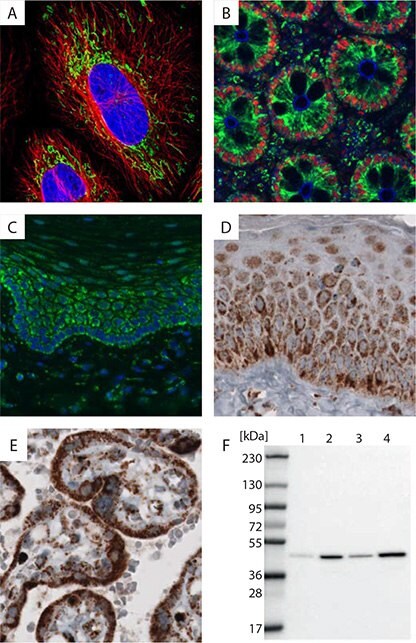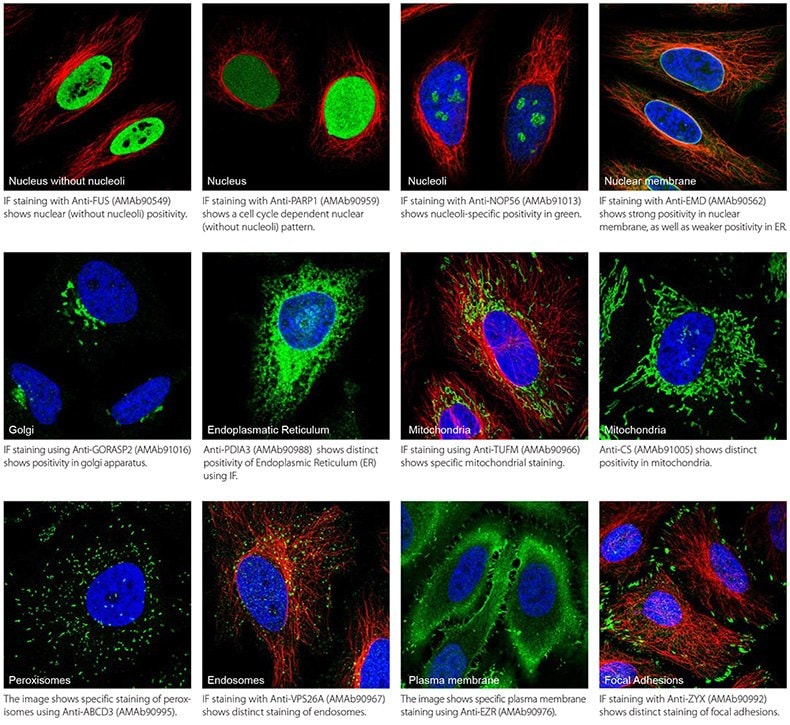Prestige Antibodies® Organelle Markers
Organelle Markers in Subcellular Localization Studies
Subcellular localization studies are important for mapping and characterizing proteins and thus for better understanding of the cellular functions of the proteins. By confocal microscopy analysis on human cell lines, spatial and temporal protein expression patterns can be visualized on a fine cellular and subcellular level. In order to facilitate interpretation of the subcellular distribution of the protein targeted by a specific antibody, the cells may be stained with reference markers for different subcellular structures, organelles, within the cells. For example, in the Human Protein Atlas project, an antibody towards calreticulin was chosen as a reference marker for the Endoplasmic Reticulum (ER). This is illustrated in Figure 1. For instance, for automated annotation of co-localization analyses, organelle specific markers are needed for every subcellular compartment to be analyzed.

Figure 1. Anti-HSP90B1 (HPA003901) staining is shown in green, nuclear reference DAPI in blue and the endoplasmic reticulum (ER) reference marker detecting calreticulin shown in yellow. The yellow signal overlaps with the green antibody signal, confirming ER-specificity.
Prestige Antibodies® Organelle Marker Panel
In collaboration with the Human Protein Atlas project, a number of reference markers for different organelles have been developed and are now being released in a first version of an Organelle Marker Panel, targeting 11 different subcellular structures within the cell. These are presented in Figure 3 and Table 1.
The Organelle Markers of the panel have been selected based primarily on the specific target recognition over a number of commonly used human cell lines, such as A-431, U-251 MG, U-2 OS, HeLa and MCF-7. Other selection criteria of the markers include high signal to noise ratio, agreement of protein-RNA expression according to RNA Seq data, detection of band of expected target size in WB, as well as correlation of positivity to the results of other antibodies towards the same protein target.
These monoclonal Organelle Markers have been developed together as a panel under the same stringent conditions as the Prestige Monoclonal Antibodies, which guarantees a secured continuity and stable supply.
The majority of the Organelle Markers in this panel are also recommended for Western Blot (WB) and Immunohistochemistry (IHC) applications, as exemplified with Anti-TUFM in Figure 2.
Anti-TUFM, Example of an Organelle Marker

Figure 2. Mitochondria can be detected by using an antibody directed against TUFM(Tu translation elongation factor), a protein specifically expressed in mitochondria. The anti-TUFM monoclonal antibody, AMAb90966, shows a specific signal in a variety of applications, including immunofluorescence immunocytochemistry (IF-ICC), chromogenic and fluorescence immunohistochemistry (IHC and IF-IHC), as well as in Western Blot (WB). A) IF-ICC staining of HeLa cell line with AMAb90966 shows distinct immunoreactivity in mitochondria (in green). Nuclei are displayed in blue (DAPI) and microtubules in red. B) IHC-IF staining of human colon tissue with mitochondrial Anti-TUFM immunoreactivity shown in green, plasma membranes in blue (Anti-EZR, AMAb90979, IgG2b) and nuclei in red (Anti-HNRNPC, AMAb91010, IgG2a). This illustrates that three mouse monoclonal antibodies of different subtypes can be used simultaneously when detected with subtypes-specific secondary antibodies. C) IHC-IF staining of human skin with Anti-TUFM immunoreactivity shown in green and nuclei in blue. D) IHC staining of human skin and E) placenta. F) WB analysis of human cell lines U251 MG (1), A-431 (2), U-2 OS (3) and MCF-7 (4).
IF Images of 11 Different Subcellular Organelles in Human HeLa Cell Line

Figure 3. Immunofluorescence images showing 11 different subcellular organelles in the human HeLa cell line using monoclonal antibodies as markers with antibody staining shown in green. Microtubule- and nuclear probes are visualized in red and blue respectively (where available).
Monoclonal Antibodies Included in the Organelle Marker Panel
This organelle marker panel of mouse monoclonal antibodies against a selection of important subcellular locations for mapping, characterizing and revealing the role of the protein in cellular processes, can be used as a reference to stain and confirm the location of the protein of interest. The panel members have been selected for high RNA levels in as many cell lines as possible and are validated in ICC-IF in up to five cell lines. Most of them are also validated in IHC and WB. All panel members belong to the Prestige Antibody brand and have been developed under the same stringent conditions, with a secured continuity and stable supply.
About the Human Protein Atlas Project
The Human Protein Atlas project was initiated in 2003 by Swedish Researchers, headed by Professor Mathias Uhlén, and funded by the Knut and Alice Wallenberg foundation. It is a unique world leading effort performing systematic exploration of the human proteome using antibodies. The Human Protein Atlas can now present a complete map of protein expression in all major organs and tissues in the human body.
The Human Protein Atlas Project has created an expression map of the complete human proteome. To accomplish this, highly specific premium antibodies are developed to all protein coding human genes and protein profiling is established in a multitude of tissues and cells using tissue arrays. Expression data is available from application-specific validation. Applications applied are immunohistochemistry, Western blot analysis, protein array assay and immunofluorescent based confocal microscopy.
To continue reading please sign in or create an account.
Don't Have An Account?